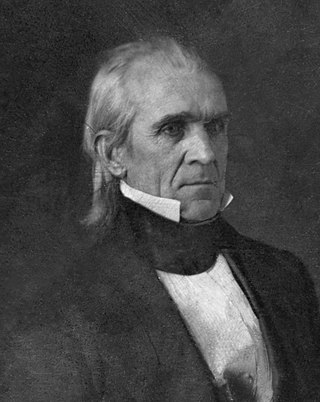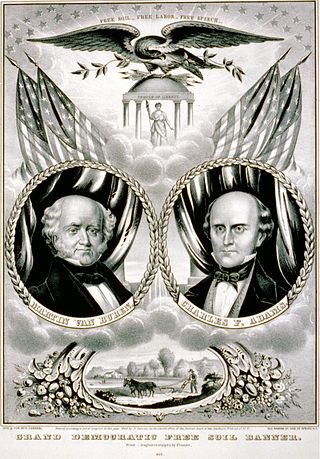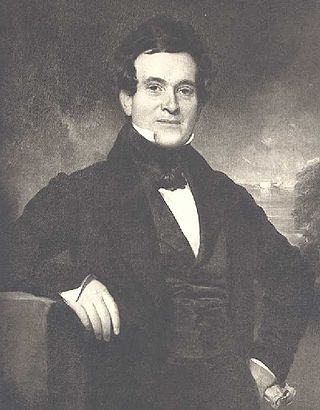
The Locofocos (also Loco Focos or Loco-focos) were a faction of the Democratic Party in American politics that existed from 1835 until the mid-1840s.

The Locofocos (also Loco Focos or Loco-focos) were a faction of the Democratic Party in American politics that existed from 1835 until the mid-1840s.
The faction, originally named the Equal Rights Party, was created in New York City as a protest against that city's regular Democratic organization, Tammany Hall. It contained a mixture of anti-Tammany Democrats and labor union veterans of the Working Men's Party, the latter of which had existed from 1828 to 1830. [1] They were vigorous advocates of laissez-faire and opponents of monopoly. Their leading intellectual was editorial writer William Leggett.
The name Locofoco derived from "locofoco, a kind of friction match". It originated when a group of Jacksonians used such matches to light candles to continue a political meeting after Tammany men tried to break up the meeting by turning off the gaslights. [2]
The Locofocos were involved in the Flour Riot of 1837. In February 1837, the Locofocos held a mass meeting in City Hall Park (New York City) to protest the rising cost of living. When the assembled crowd learned that flour had been hoarded at warehouses on the Lower East Side, hundreds rushed to the warehouses resulting in the arrest of 53 people. The New York State Assembly blamed the Locofocos for the unrest and opened an investigation into them. [3]
The Locofocos never controlled the party nationally and declined after 1840, when the federal government passed the Independent Treasury Act. This assured them that the government would not resume its involvement in banking, which had been a key aim of the faction. [4] In the 1840 election, the term Locofoco was applied to the entire Democratic Party by its Whig opponents, both because Democratic President Martin Van Buren had incorporated many Locofoco ideas into his economic policy, and because Whigs considered the term to be derogatory.
In general, Locofocos supported Andrew Jackson and Van Buren, and were for free trade, greater circulation of specie, legal protections for labor unions and against paper money, financial speculation, and state banks. Among the prominent members of the faction were William Leggett, William Cullen Bryant, Alexander Ming Jr., John Commerford, Levi D. Slamm, Abram D. Smith, Henry K. Smith, Isaac S. Smith, Moses Jacques, Gorham Parks, and Walt Whitman (then a newspaper editor).
Ralph Waldo Emerson said of the Locofocos: "The new race is stiff, heady, and rebellious; they are fanatics in freedom; they hate tolls, taxes, turnpikes, banks, hierarchies, governors, yea, almost all laws." [5]
Locofocoism influenced Canadian politics through William Lyon Mackenzie. Mackenzie, an influential newspaper publisher and parliamentarian, became sympathetic to the Locofocs after meeting Andrew Jackson in 1829. [6] [7] Frustrated by Tory control of Canadian politics, Mackenzie led the 1837 Upper Canada Rebellion and proclaimed a short-lived "Republic of Canada" during the Patriot War with help from American militias. [7] Locofoco Abram Smith and many others would become active in American Hunter’s Lodges dedicated to ending British rule in Canada.
Mackenzie was imprisoned for violating the Neutrality Act during the Patriot War, but pressure from sympathetic Locofocos and others forced President Martin Van Buren to pardon Mackenzie in 1840. [8] William Lyon Mackenzie later became an American citizen and Locofoco politician before returning to Canada. [9]
The name Loco-foco was originally used by John Marck for a self-igniting cigar, which he had patented in April 1834. [10] [11] Marck, an immigrant, invented his name from a combination of the Latin prefix loco- , which as part of the word locomotive had recently entered general public use, and was usually misinterpreted to mean "self", and a misspelling of the Italian word fuoco for "fire". [11] Therefore, Marck's name for his product was originally meant in the sense of "self-firing". It appears that Marck's term was quickly genericized to mean any self-igniting match, and it was this usage from which the faction derived its name.
The Whigs quickly seized upon the name, applying an alternate derivation of Loco Foco, from the combination of the Spanish word loco, meaning mad or crack-brained, and foco, from "focus" or fuego meaning "fire". [12] Their meaning then was that the faction and later the entire Democratic party, was the "focus of folly". [13] The use of Locofoco as a derogatory name for the Democratic party continued well into the 1850s, even following the dissolution of the Whig Party and the formation of the Republican Party by former urban Workingmen Locofocos, anti-slavery Know Nothings, Free Soilers, Conscience Whigs, and Temperance Whigs. [14] [15] [16]

Martin Van Buren was an American lawyer, diplomat, and statesman who served as the eighth president of the United States from 1837 to 1841. A primary founder of the Democratic Party, he served as New York's attorney general and U.S. senator, then briefly as the ninth governor of New York before joining Andrew Jackson's administration as the tenth United States secretary of state, minister to Great Britain, and ultimately the eighth vice president when named Jackson's running mate for the 1832 election. Van Buren won the presidency in 1836 against divided Whig opponents, the first president of non-Anglo-Saxon heritage and so far the only speaking English as a second language. Van Buren lost re-election in 1840, and failed to win the Democratic nomination in 1844. Later in his life, Van Buren emerged as an elder statesman and an important anti-slavery leader who led the Free Soil Party ticket in the 1848 presidential election.
The Whig Party was a conservative political party that existed in the United States during the mid-19th century. Alongside the slightly larger Democratic Party, it was one of the two major parties in the United States between the late 1830s and the early 1850s as part of the Second Party System. Four presidents were affiliated with the Whig Party for at least part of their terms. Other prominent members of the Whig Party include Henry Clay, Daniel Webster, Rufus Choate, William Seward, John J. Crittenden, and John Quincy Adams. The Whig base of support was centered among entrepreneurs, professionals, planters, social reformers, devout Protestants, and the emerging urban middle class. It had much less backing from poor farmers and unskilled workers.

The 1840 United States presidential election was the 14th quadrennial presidential election, held from Friday, October 30 to Wednesday, December 2, 1840. Economic recovery from the Panic of 1837 was incomplete, and Whig nominee William Henry Harrison defeated incumbent President Martin Van Buren of the Democratic Party. The election marked the first of two Whig victories in presidential elections, but was the only one where they won a majority of the popular vote. This was the third rematch in American history, which would not occur again until 1892.

The 1844 United States presidential election was the 15th quadrennial presidential election, held from Friday, November 1 to Wednesday, December 4, 1844. Democrat James K. Polk defeated Whig Henry Clay in a close contest turning on the controversial issues of slavery and the annexation of the Republic of Texas. This is the only election in which both major party nominees served as Speaker of the House at one point, and the first in which neither candidate held elective office at the time.

The 1848 United States presidential election was the 16th quadrennial presidential election, held on Tuesday, November 7, 1848. In the aftermath of the Mexican–American War, General Zachary Taylor of the Whig Party defeated Senator Lewis Cass of the Democratic Party.

The Free Soil Party was a short-lived coalition political party in the United States active from 1848 to 1854, when it merged into the Republican Party. The party was largely focused on the single issue of opposing the expansion of slavery into the western territories of the United States.

Jacksonian democracy was a 19th-century political philosophy in the United States that expanded suffrage to most white men over the age of 21 and restructured a number of federal institutions. Originating with the seventh U.S. president, Andrew Jackson and his supporters, it became the nation's dominant political worldview for a generation. The term itself was in active use by the 1830s.

Fernando Wood was an American Democratic Party politician, merchant, and real estate investor who served as the 73rd and 75th Mayor of New York City. He also represented the city for several terms in the United States House of Representatives.
The Albany Regency was a group of politicians who controlled the New York state government between 1822 and 1838. Originally called the "Holy Alliance", it was instituted by Martin Van Buren, who remained its dominating spirit for many years. The group was among the first American political machines. In the beginning they were the leading figures of the Bucktails faction of the Democratic-Republican Party, later the Jacksonian Democrats and finally became the Hunkers faction of the Democratic Party.

The Second Party System was the political party system operating in the United States from about 1828 to 1852, after the First Party System ended. The system was characterized by rapidly rising levels of voter interest, beginning in 1828, as demonstrated by Election Day turnouts, rallies, partisan newspapers, and high degrees of personal loyalty to parties.

William Leggett was an American poet, fiction writer, and journalist.

Aaron Clark was an American politician who became the second popularly elected Mayor of New York, serving two one-year terms from 1837 to 1839. He was a member of the Whig Party.

Isaac Leggett Varian was a New York state legislator and the 63rd Mayor of New York City.
Gorham Parks was a U.S. Representative from Maine, and a Democratic Party candidate for Maine Governor.

The presidency of Martin Van Buren began on March 4, 1837, when Martin Van Buren was inaugurated as President of the United States, and ended on March 4, 1841. Van Buren, the incumbent vice president and chosen successor of President Andrew Jackson, took office as the eighth United States president after defeating multiple Whig Party candidates in the 1836 presidential election. A member of the Democratic Party, Van Buren's presidency ended following his defeat by Whig candidate William Henry Harrison in the 1840 presidential election.

The 1844 Democratic National Convention was a presidential nominating convention held in Baltimore, Maryland from May 27 through 30. The convention nominated former Governor James K. Polk of Tennessee for president and former Senator George M. Dallas of Pennsylvania for vice president.
William M. Gouge was an American economist who published A Short History of Paper Money and Banking in the United States, an 1833 treatise that advocated for hard money policies. Following the publication of his treatise, Gouge emerged as an important figure in the presidential administrations of Andrew Jackson and Martin Van Buren, and he played a major role in the creation of the Independent Treasury system. Historian Sean Wilentz writes that, "if anyone was the intellectual architect of Jacksonian economic policy after 1832, it was the Philadelphia radical William Gouge".

This is a select bibliography of Post World War II books and journal articles about Martin Van Buren, an American statesman who served as the eighth president of the United States from 1837 to 1841.
The 1838 Massachusetts gubernatorial election was held on November 12.

"Radicalism" or "radical liberalism" was a political ideology in the 19th century United States aimed at increasing political and economic equality. The ideology was rooted in a belief in the power of the ordinary man, political equality, and the need to protect civil liberties.
Loco Foco.
John Marck self igniting cigar.
the idea of that song is basically contrasting … the idea of reactionary movements before labor organized really into the unions we have today, reactionary movements of the 19th Century, with today